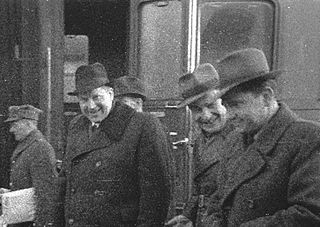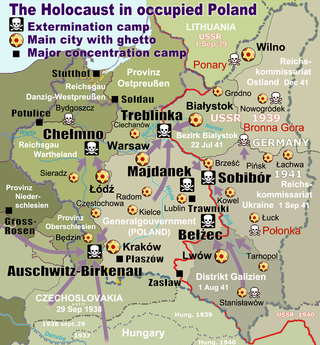
Zofia Kossak-Szczucka was a Polish writer and World War II resistance fighter. She co-founded two wartime Polish organizations: Front for the Rebirth of Poland and Żegota, set up to assist Polish Jews to escape the Holocaust. In 1943, she was arrested by the Germans and sent to Auschwitz concentration camp, but survived the war.

Żegota was the Polish Council to Aid Jews with the Government Delegation for Poland, an underground Polish resistance organization, and part of the Polish Underground State, active 1942–45 in German-occupied Poland. Żegota was the successor institution to the Provisional Committee to Aid Jews and was established specifically to save Jews. Poland was the only country in German-occupied Europe where such a government-established and -supported underground organization existed.

During World War II, some individuals and groups helped Jews and others escape the Holocaust conducted by Nazi Germany.

Irena Stanisława Sendler (née Krzyżanowska), also referred to as Irena Sendlerowa in Poland, nom de guerreJolanta, was a Polish humanitarian, social worker, and nurse who served in the Polish Underground Resistance during World War II in German-occupied Warsaw. From October 1943 she was head of the children's section of Żegota, the Polish Council to Aid Jews.

Righteous Among the Nations is an honorific used by the State of Israel to describe non-Jews who risked their lives during the Holocaust to save Jews from extermination by the Nazis for altruistic reasons. The term originates with the concept of "righteous gentiles", a term used in rabbinic Judaism to refer to non-Jews, called ger toshav, who abide by the Seven Laws of Noah.

Henryk Woliński (1901–1986) was a member of the Polish resistance movement in World War II, specifically the Armia Krajowa (AK), where he reached the rank of colonel. He was the head of the "Jewish Department" in AK's Bureau of Information and Propaganda. His codename was "Wacław". He was recognized by Yad Vashem as one of the Righteous among the Nations. He himself harbored in his apartment over 25 Jews for a period going from a few days to several weeks.

Jan Żabiński and his wife Antonina Żabińska (1908–1971) were a Polish couple from Warsaw, recognized by Yad Vashem as Righteous Among the Nations for their heroic rescue of Jews during the Holocaust in Poland. Jan Żabiński was a zoologist and zootechnician by profession, a scientist, and organizer and director of the renowned Warsaw Zoo before and during World War II. He became director of the Zoo before the outbreak of war but during the occupation of Poland also held a prestigious function of the Superintendent of the city's public parks in 1939–1945. A street in Warsaw is named after him.

Julian Grobelny was an activist in the Polish Socialist Party (PPS) from 1915, in the lead-up to Poland's return to independence. During the interwar period he was a social activist. After the German-Soviet invasion of Poland in 1939, and the ensuing Holocaust, he became President of Żegota active in the General Government territory of occupied Poland. The clandestine organization was named after a fictional character Konrad Żegota born on the exact day of its inception in 1942. Grobelny served as president of Żegota until the end of hostilities.

Ferdynand Marek Arczyński, cryptonym "Marek" or "Lukowski", was one of the founding members of an underground organization Żegota in German-occupied Poland, from 1942 to 1945. Żegota's express purpose was to help the country's Jews survive the Holocaust; find places of safety for them, and provide relief payments to thousands of families. Poland was the only country in occupied Europe with such an organization during World War II.

Irena Adamowicz, was a Polish-born scout leader and a resistance member during World War II. She was a courier for the underground Home Army. In 1985, Adamowicz was posthumously bestowed the title of the Righteous Among the Nations by Yad Vashem in Jerusalem for her activities involving providing information to a number of Jewish ghettos in occupied Poland.

Polish Jews were the primary victims of the Nazi Germany-organized Holocaust in Poland. Throughout the German occupation of Poland, Jews were rescued from the Holocaust by Polish people, at risk to their lives and the lives of their families. According to Yad Vashem, Israel's official memorial to the victims of the Holocaust, Poles were, by nationality, the most numerous persons identified as rescuing Jews during the Holocaust. By January 2022, 7,232 people in Poland have been recognized by the State of Israel as Righteous among the Nations.
Jerzy and Irena Krępeć, a Polish husband and wife, living in Gołąbki near Warsaw during Nazi German occupation of Poland in World War II, were the Righteous who rescued Polish Jews with families including refugees from the Ghetto in Warsaw during the Holocaust.

The Mińsk Mazowiecki Ghetto or the Mińsk Ghetto was a World War II ghetto set up by Nazi Germany in occupied Poland. Some 7,000 Polish Jews were imprisoned there from all neighbouring settlements for the purpose of persecution and exploitation. Two years later, beginning 21 August 1942 during the most deadly phase of the Holocaust in occupied Poland, they were rounded up – men, women and children – and deported to Treblinka extermination camp aboard Holocaust trains. In the process of Ghetto liquidation, some 1,300 Jews were summarily executed by the SS in the streets of Mińsk Mazowiecki.

Stanisławów Ghetto was a ghetto established in 1941 by Nazi Germany in Stanisławów in German occupied Poland. After the German invasion of the Soviet Union, the town was incorporated into District of Galicia, as the fifth district of the General Government.

The Lutsk Ghetto was a Nazi ghetto established in 1941 by the SS in Lutsk, Western Ukraine, during World War II. In the interwar period, the city was known as Łuck and was part of the Wołyń Voivodeship (1921–1939) in the Second Polish Republic.

Sambor Ghetto was a Nazi ghetto established in March 1942 by the SS in Sambir, Western Ukraine. In the interwar period, the town (Sambor) was part of the Second Polish Republic. In 1941, the Germans captured the town at the beginning of Operation Barbarossa. According to the Polish census of 1931, Jews constituted nearly 29 percent of the town's inhabitants, most of whom were murdered during the Holocaust. Sambor (Sambir) is not to be confused with the much smaller Old Sambor located close by, although their Jewish history is inextricably linked together.

Jan Grabowski is a Polish-Canadian professor of history at the University of Ottawa, specializing in Jewish–Polish relations in German-occupied Poland during World War II and the Holocaust in Poland.

Ładoś Group, Bernese Group is a name given to a group of Polish diplomats and Jewish activists who during Second World War elaborated in Switzerland a system of illegal production of Latin American passports aimed at saving European Jews from the Holocaust.


































